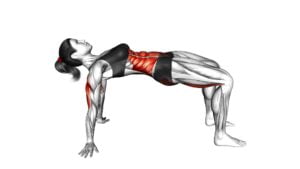Table Top Bridge – Video Exercise Guide & Tips

Get ready to strengthen your core and improve your flexibility with the Table Top Bridge exercise. In this video exercise guide, we'll show you the proper form, variations, and common mistakes to avoid.
Watch This Exercise Video
Plus, we'll share tips for increasing the intensity and important safety precautions. Whether you're a beginner or advanced, this exercise will challenge and benefit you.
So grab a mat and let's get started!
Key Takeaways
- Position yourself properly by lying on your back with knees bent and feet flat on the floor, lifting hips to form a straight line from knees to shoulders.
- Avoid common mistakes such as sagging hips or arching the back, and perform the exercise slowly and with control to engage core and glutes effectively.
- Incorporate variations of the Table Top Bridge, such as single-leg or marching variations, to target different muscles and improve balance and stability.
- Increase the intensity of the exercise by elevating feet onto a stability ball or bench, using resistance bands, or adding variations to challenge the core and glutes.
Proper Form for Table Top Bridge
To perform the Table Top Bridge exercise correctly, begin by positioning yourself on your back with your knees bent and feet flat on the floor. This exercise is a great way to strengthen your core and glutes while also improving your posture.
However, there are some common mistakes to avoid in order to get the most out of this exercise.
One mistake to avoid is lifting your hips too high, which can put unnecessary strain on your lower back. Instead, focus on lifting your hips just high enough to form a straight line from your knees to your shoulders.
Another mistake is letting your knees fall out to the sides. Keep your knees in line with your hips to engage your glutes properly.
The benefits of the Table Top Bridge are numerous. It not only targets your glutes and core, but also helps to improve hip mobility and stability. Additionally, it can alleviate lower back pain and improve posture by strengthening the muscles that support your spine.
In the next section, we'll explore variations of the Table Top Bridge that can add variety and challenge to your workout routine.
Variations of Table Top Bridge
Now let's explore some variations of the Table Top Bridge to add variety and challenge to your workout routine.
The Table Top Bridge is a great exercise for strengthening your glutes, hamstrings, and core. However, if you're looking for alternative exercises that target these muscles in different ways, there are a few variations you can try.
One variation is the Single Leg Table Top Bridge. To perform this exercise, start in the regular Table Top Bridge position and then extend one leg straight out in front of you. This will increase the intensity and engage your glutes and hamstrings even more.
Another variation is the Marching Table Top Bridge. In this exercise, you lift one leg off the ground and bring your knee towards your chest, then lower it back down and repeat with the other leg. This exercise not only targets your glutes and hamstrings but also helps to improve your balance and stability.
By incorporating these alternative exercises into your routine, you can continue to reap the benefits of the Table Top Bridge while challenging your muscles in different ways.
Now let's move on to the next section where we'll discuss common mistakes to avoid in the Table Top Bridge.
Common Mistakes to Avoid in Table Top Bridge
Are you making any common mistakes in your Table Top Bridge exercise?
It's important to be aware of these common misconceptions to ensure that you're getting the most out of your workout.
One common mistake isn't maintaining proper form. Many people tend to sag their hips or arch their backs, which can lead to injury and reduce the effectiveness of the exercise.
Another mistake is rushing through the movement. Table Top Bridge is meant to be done slowly and with control, focusing on engaging the core and glutes. By rushing, you aren't giving your muscles enough time to fully activate and work.
Additionally, not breathing properly during the exercise is a common mistake. It's important to exhale as you lift your hips and inhale as you lower them, as this helps to engage the deep core muscles and improve stability.
Lastly, not progressing the exercise is a mistake. Once you have mastered the basic Table Top Bridge, it's important to challenge yourself by adding variations or increasing the difficulty level to continue seeing progress.
Tips for Increasing the Intensity of Table Top Bridge
To increase the intensity of your Table Top Bridge exercise, try incorporating these tips. For advanced modifications, you can elevate your feet onto a stability ball or a bench to challenge your core and glutes even more. This will require greater stability and strength to maintain the bridge position.
Another option is to perform single-leg Table Top Bridges, where you extend one leg straight out while keeping the other leg bent. This variation targets your hamstrings and glutes on one side at a time, making the exercise more challenging.
Incorporating resistance bands into your Table Top Bridge can also increase the intensity. Place a resistance band around your thighs, just above your knees, and press your knees out against the band as you lift your hips. This activates your glutes and outer thighs, adding an extra challenge to the exercise. You can also use resistance bands around your feet to add resistance as you extend your legs or perform other variations of the exercise.
By incorporating these advanced modifications and resistance bands, you can take your Table Top Bridge exercise to the next level and maximize its effectiveness.
Now, let's move on to important safety precautions for performing the Table Top Bridge.
Safety Precautions for Table Top Bridge
What precautions should you take when performing the Table Top Bridge exercise? Here are some important safety measures to keep in mind:
- Maintain proper form: Make sure to align your body correctly and engage your core muscles throughout the exercise. This will help protect your lower back and prevent strain or injury.
- Start with a stable surface: Perform the Table Top Bridge on a firm and non-slip surface to ensure stability and reduce the risk of slipping or falling.
- Listen to your body: Pay attention to any discomfort or pain during the exercise. If you experience any sharp or intense pain, stop immediately and consult a healthcare professional.
The Table Top Bridge exercise isn't only a great way to strengthen your core muscles but also offers several benefits when incorporated into your workout routine. It helps improve core stability, which is essential for maintaining proper posture, balance, and overall body strength. Additionally, this exercise targets the glutes, hamstrings, and lower back, helping to tone and strengthen these areas.
Frequently Asked Questions
Are There Any Modifications That Can Be Made to the Table Top Bridge Exercise for People With Knee or Wrist Pain?
If you experience knee or wrist pain, modifications can be made to the table top bridge exercise.
For knee modifications, you can try placing a foam pad or folded towel under your knees for extra cushioning.
To protect your wrists, you can use wrist wraps or perform the exercise on your forearms instead.
These modifications can help alleviate discomfort and allow you to still benefit from the exercise.
How Often Should I Perform the Table Top Bridge Exercise for Optimal Results?
For optimal results, perform the table top bridge exercise regularly. The optimal frequency depends on your fitness level and goals. Beginners can start with 2-3 times a week and gradually increase as they get stronger. It's important to listen to your body and not overdo it. Remember to maintain proper form throughout the exercise.
Additionally, there are variations available for beginners to make the exercise more manageable.
Can the Table Top Bridge Exercise Help Improve Posture and Alleviate Back Pain?
Improving posture and alleviating back pain are two potential benefits of the table top bridge exercise.
By engaging your core and glute muscles, this exercise can help strengthen the muscles that support your spine and promote better alignment.
Regularly incorporating the table top bridge into your workout routine can contribute to improved posture and potentially provide relief from back pain.
Remember to consult with a healthcare professional before starting any new exercise program.
Is It Necessary to Warm up Before Performing the Table Top Bridge Exercise?
Before performing the table top bridge exercise, it's important for you to warm up. Warm up exercises prepare your muscles and joints for the upcoming physical activity, reducing the risk of injury. Warming up increases blood flow, improves flexibility, and enhances performance.
It also helps to elevate your heart rate gradually. So, make sure to dedicate a few minutes to warming up before engaging in the table top bridge exercise for optimal results and to avoid any potential harm.
Are There Any Specific Breathing Techniques to Follow While Doing the Table Top Bridge Exercise?
When performing the table top bridge exercise, it's important to focus on your breathing. There are specific breathing techniques that can enhance the benefits of this exercise.
By inhaling deeply through your nose and exhaling slowly through your mouth, you can engage your core muscles more effectively and improve stability. This controlled breathing also helps to oxygenate your muscles and increase relaxation.
Incorporating these breathing techniques into your table top bridge routine can enhance its effectiveness.
Conclusion
In conclusion, the table top bridge exercise is a great way to strengthen your core, glutes, and hamstrings. By maintaining proper form, avoiding common mistakes, and gradually increasing the intensity, you can maximize the benefits of this exercise.
Remember to always prioritize safety by starting with a proper warm-up and consulting with a fitness professional if you have any concerns or injuries.
Incorporate the table top bridge into your workout routine for a stronger and more stable body.

Author
Years ago, the spark of my life’s passion ignited in my mind the moment I stepped into the local gym for the first time. The inaugural bead of perspiration, the initial endeavor, the very first surge of endorphins, and a sense of pride that washed over me post-workout marked the beginning of my deep-seated interest in strength sports, fitness, and sports nutrition. This very curiosity blossomed rapidly into a profound fascination, propelling me to earn a Master’s degree in Physical Education from the Academy of Physical Education in Krakow, followed by a Sports Manager diploma from the Jagiellonian University. My journey of growth led me to gain more specialized qualifications, such as being a certified personal trainer with a focus on sports dietetics, a lifeguard, and an instructor for wellness and corrective gymnastics. Theoretical knowledge paired seamlessly with practical experience, reinforcing my belief that the transformation of individuals under my guidance was also a reflection of my personal growth. This belief holds true even today. Each day, I strive to push the boundaries and explore new realms. These realms gently elevate me to greater heights. The unique combination of passion for my field and the continuous quest for growth fuels my drive to break new ground.



